Tarot Beginner Resources & Shuffling and Card Pulling Methods (Podcast 3 Blog)
So you have your first deck. Now what?
After buying your first deck, one of the first things you can do to get to know the cards is to open up your deck and look at all the cards. Hold each card to connect with them and really study the images on each card. If you have a tarot journal, write down your first impressions of each card: what you notice, what colors are prominent, what does your eye go to first in the image, what do you think the meaning of the card is. Write all of this down for each tarot card.
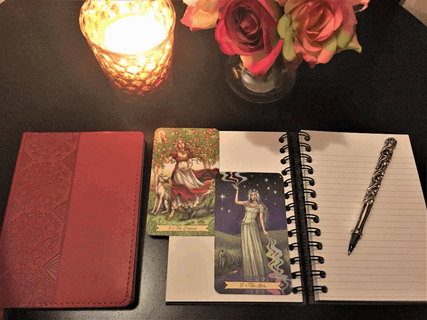
I suggest you come back to this process a year later to redo this exercise to see how your view of that card might have changed as you work with the cards over time. Take your time with this step so that you fully connect with the deck as a whole.
The next step is an important one. You will need to decide on the resources you want to use to learn the tarot card meanings. These will include any tarot books you want to read or reference and any online sites you want to use to consult for the tarot meanings as you start to work with pulling cards for yourself.
There are a few books I recommend starting with. I have read 20 tarot books over the past 2.5 years, and I narrowed down 3 that I think are ideal for tarot beginners. The ones I recommend are WTF is Tarot and How Do I do it by Bakara Wintner, Kitchen Table Tarot by Melissa Cynova, and 78 Degrees of Wisdom by Rachel Pollack. I chose WTF is Tarot and Kitchen Table Tarot because they are easy to digest in a short period of time, and they use modern language to explain the cards with great life examples for each card. 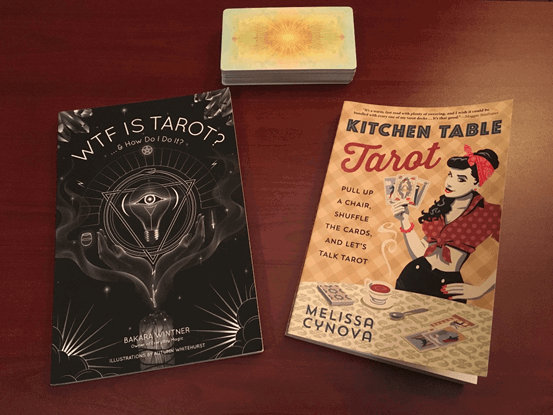
I find that most beginners find these books the most fun to read and find them very relatable. I really enjoyed these myself, and WTF is Tarot is by far my favorite book I’ve read so far. 78 Degrees of Wisdom is the main source people usually start with, as this book has been in print since 1980 and is a staple on the shelves of most tarot readers. Rachel Pollack is well renowned in the tarot community and has studied and written about tarot for over 40 years. There is a 3rd edition of this book that was just released in 2019. 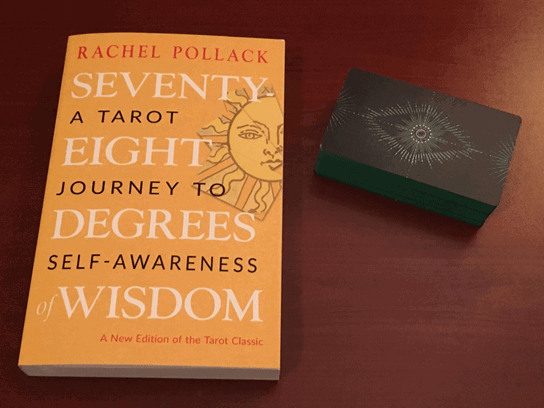
I have a list of other resources to study that I will cover in a later podcast where I break down the resources into beginner, intermediate and advanced levels. For this first stage, those 3 are the reference sources I suggest for those just starting out on their tarot journey.
Biddytarot.com is a free online resource that I used to learn the card meanings when I first started out. I find this is one of the easiest ways to learn each card. As you pull a card, google the card and biddytarot.com comes up as the first result almost every time. Her meanings for the upright and reversed meanings are concise and easy to understand. This is such a valuable site for beginners because it is online and free. Check it out!

To connect with your cards, you can sleep with the cards next to your bed at night or under your pillow to bond with the energy of the deck and to help the cards soak up your energy as well. If you have an altar, you can place your cards on your altar. Shuffle as much as possible. This infuses the entire deck with your energy. It will start to feel like the cards are part of you, and you will work as one. It starts to feel like a natural fluid motion. The only way to get to that point is to shuffle as much as you can. I spent many nights shuffling as we watched tv to get comfortable with the feel of each deck I’ve bought. This really works! I think it’s best to jump right into pulling cards for yourself as you get to know the meanings. Start with 1 card pulls daily to help you learn each card and read the meaning in your preferred resource book. When you feel comfortable advancing, move to pulling 3 card spreads.
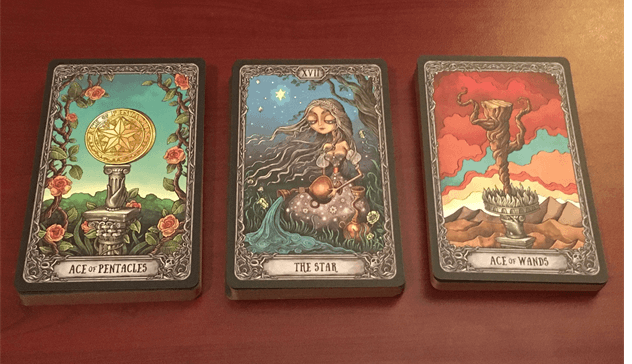
When you first start working with the cards, you may be wondering how to shuffle and pull the cards. There are several methods you can choose from. This was something I spent a lot of time looking online for when I first started, and I was disappointed that I couldn’t find many videos showing the options. Luckily, some of my favorite readers have recently recorded some videos that show how they approach shuffling methods. I included links at the bottom of this blog for the videos uploaded by Avalon Cameron and Ethony Dawn. It might be easier to see the options visually after I walk you through them. Their videos are fantastic, and I wish they had been around when I got started with the cards. I have also included photos of me demonstrating the various shuffling methods below.
Many readers riffle shuffle, which is when you shuffle 2 piles of cards into each other casino style. This can be hard on the decks and cause some decks to wear out quickly. It can also create a bend in the middle of the decks. It can be awkward to learn and even difficult for those of us with arthritis and carpal tunnel.
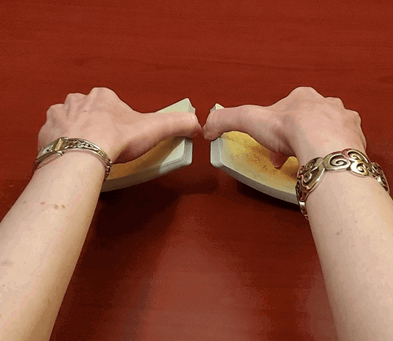
The method I prefer to that is corner riffle shuffling, where you just overlap the 2 piles of cards at the corners and gently fold them into one pile. This is less harsh on the deck and can preserve the cards for a longer period of time. It is also better on the hands. 
Another method I prefer is over hand shuffling. You can either do this by holding the deck in your hand horizontally in landscape position OR you can stand the cards up tall in your hand and shuffle them vertically in portrait position. Photo below is horizontal shuffling method.
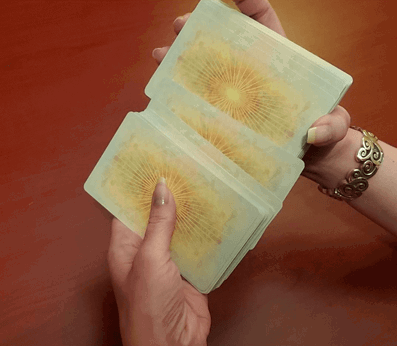
For larger decks it is easier to hold them upright, so you don’t stretch out your hand too much. Then you just fold the cards from the back over the top and let the cards fall over each other to mix them up. In this method you use your thumb to help grab and stabilize the cards in the front. You can even alternate and let the cards fall in the front and then the back of the deck to further mix the cards up, whichever feels more natural. Below is vertical shuffling method.
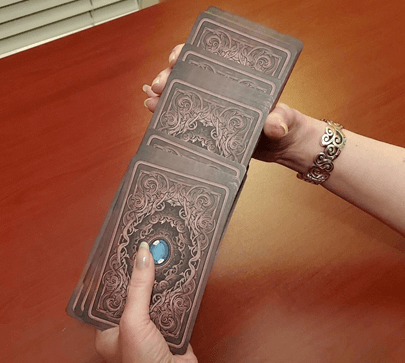
An easy shuffling method is to deal cards into piles to randomize them or hold the whole deck and gently drop portions of the cards into different piles. Then you can combine the piles back into one pile and pull cards. This is great for beginners. Below is the drop method.

Some readers spread the cards around on a table or desktop to mix them up and then pick cards randomly from the piles of mixed cards OR you can gather the mixed cards back into a pile to pull the cards. This is called the washing machine method and great for getting reversal cards. This is easy for those that struggle with the other shuffling methods, and it is easy to spin and mix the cards up quickly.
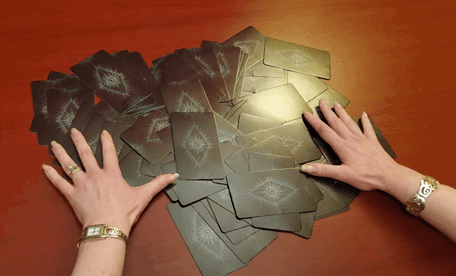
Just like shuffling there are multiple methods for pulling cards. Below I will cover a variety of these methods.
One simple method is just to start shuffling the deck with any method you prefer and pull any card you feel drawn to as you are shuffling or sometimes you will feel or hear the word “pull.” Then you know to pull that card. You may feel the need to stop shuffling because it feels complete, and you know to pull a card at that time either from the top or middle of the deck. Go with your gut.
Or cards may fly out while shuffling. I always read those jumpers because I feel those are important messages! If you are pulling cards in a particular spread, you can put the jumpers to the side and still consider them after you pull cards for each position. There are times when I use all flyers or jumpers for the entire reading. There are just some decks that produce flyers easily, and it is a lot of fun to watch the cards fly. It feels pretty magical too. And clients LOVE flyers! There is a flair to it!
Photo below shows flyers as they jumped out of the deck after shuffling.

You can split the deck after shuffling and choose the middle card, which would be the top card of the remaining cards after you pull the top half of the deck off. If you are pulling multiple cards, just keep pulling cards from that spot in the deck.

Another method is to shuffle and divide the deck into 3 piles and turn over the top card on each of the piles, especially if you are doing a 3 card spread. This is quick and easy! Or a slight variation on that method is to divide the deck into those 3 piles, and you can stack all the piles back up in the order that feels right to you and turn over the top card and continue pulling all cards from the top of the deck. Experiment with which version you like better.

Another option is to shuffle the deck and then hold the deck in your dominant hand and use your nondominant hand to lift the deck up and pull the cards that feel right from different parts of the deck. This is my preferred method with decks that easily separate, which are usually those with thin card stock and don’t easily stick together. It becomes instinct on which cards to pull. I like this method with worn in decks because you can easily slip your hand into the deck and pull multiple cards quickly and it is completely intuitive. After you get the hang of it, your hand knows exactly which part of the deck to pull from. This technique is demonstrated in several of my photos below. 
The following are more photos of me pulling cards from different parts of the deck in the same spread.
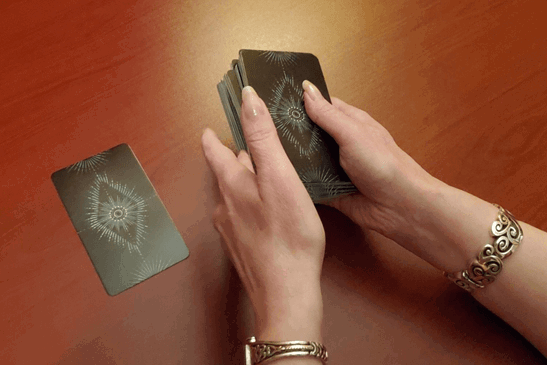
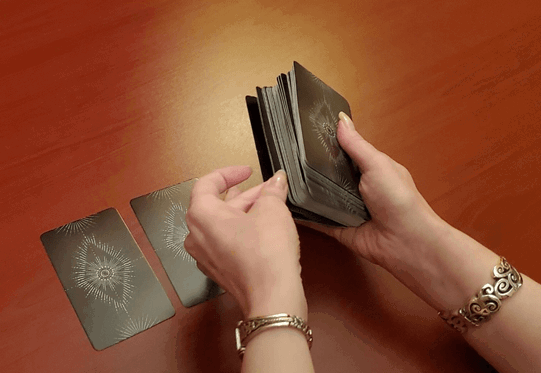
An extremely easy way to split the deck is to hold the deck in one hand after ample shuffling and let the deck slide gently into your other hand, and where the cards naturally split is where you pull cards from. This is like letting a book gently fall open to a random page. You just find that natural break in the cards. Again, this is great for beginners because it is easy.
I use this next method quite a bit. When over hand shuffling vertically, some cards will pop up at the top and are obviously sticking out from the rest of the cards. Sometimes, I pull my cards from those cards.
A general guideline to use is that if a card draws your focus while shuffling, you pull those cards. They are vying for your attention. Remember the cards are speaking to you. When they stand out, listen!
Photos below show what pop up cards look like in the process of shuffling. You will intuitively feel when to pull from these cards.


Traditionally in pop culture, you will see the tarot reader shuffle the cards and fan them out on a table and pick cards from the fan. The reader or querent can wave their hands over the cards and scan the cards and choose when they feel their hand get hot, cold or tingly. That is energy you are feeling in your hand. Typically, you do this with your non-dominant hand because is your intuitive hand. So, if you are right handed you would use your left hand and vice versa.
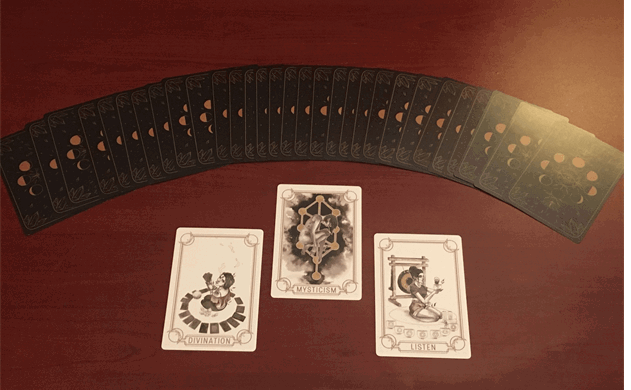
A very creative way to pull cards that I have just learned about from Ethony is to use dice to determine how many cards to pull in your spread. So, if you roll a 3, you pull a 3 card spread. Then you roll each time to determine how many cards you will count off the top of the deck until you pull the card for each position. So, if you roll a 4 you, then count off 3 cards and pull the 4th for the position. And you keep rolling for each card position. You return the discarded cards to the bottom of the deck each time. Ethony Dawn’s youtube shuffling video shows this cool method in action. That video link is at the bottom of this blog. This is a new method to me, and I want to experiment with it because it seems like a creative way to spice up my readings. I’m always looking for new methods to try out.
The are some factors that will inform the method you choose for shuffling and pulling cards. Cardstock and the size of the deck are the factors that matter the most to me. Bigger decks can be hard to handle as they stretch your hands and will put strain on your hands over time. Those larger cards may need to be shuffled with the overhand vertical method.
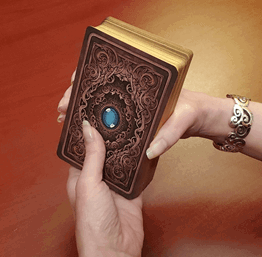
Thicker card stock can make it difficult to riffle shuffle because the cards don’t have much give and aren’t flexible. If the cards are too stiff or sticky and hard to break apart, you can use fanning powder to help the cards slide better, and this helps break in the cards to make them easier to shuffle. I have had success with this on some indie decks with thick card stock. I found fanning powder on amazon. Walmart also carries this product. You sprinkle the powder on each card and rub it in with a cloth and wipe off any excess powder. Then the cards slide over each other perfectly.
If you read reversals, you may want to split the deck and take one pile and turn it around before shuffling the cards together to help randomize them. Do this as many times as you feel necessary. Some decks have non reversal backs. So, you can tell if the cards are reversed, which can be difficult if you want to pull cards with no clue if they are upright or not.
I will note here that if you do read with reversals, you want to put the cards back upright before reading for another client so that the previous reading doesn’t impact the new reading. This resets the deck. Then you have to start the whole process of reversing cards again, but you want it to be randomized. This takes extra time but worth it.
Now that we have covered a variety of shuffling and card pulling options, my advice is to try all of these methods and after practicing with them see which method or methods you gravitate towards.
1 or 2 methods may feel more natural for you. That is most likely the method you will stick with. Of course, you can even mix shuffling methods if you feel like it. Much of the time I will corner riffle shuffle a few times and then over hand shuffle until I am ready to pull cards. What is important is that whatever option you decide to go with set that intention as you start to shuffle the cards for your reading.
But don’t over think it. Feel into the cards and lean into the process. You will intuitively feel what is right for the deck or spread you are working with that moment. I work intuitively with my decks. So, I shuffle differently with each deck. They all have a different feel in my hands, so I handle them differently. But each reader is different in this regard. You will find your own style.
If you are forcing it, it won’t feel natural. Think of tarot as more of an art than anything else. You get better results when you go with the flow and follow the energy where it naturally flows. Forcing things blocks that creative flow and connection with the cards. When in doubt let the cards and the energy guide you and shut your analytical mind off for a while. Tarot is my main form of meditation so shutting my brain down is one of the first things I do when shuffling. I then let my intuition guide me.
When starting a reading, my personal method is to knock on the deck 3 times on the top of the deck and 3 times on the bottom of the deck to infuse my energy into the deck and reset my cards for the next question. If anyone has touched your deck recently, then knocking your energy into it clears it and resets it.
I then set my intention of how I will be pulling cards as I focus on the question I am reading on. Sometimes this isn’t even a conscious thought though. Sometimes my hands just know how to shuffle the deck, and I go with it. I continue to focus on the question the entire time I am shuffling.
Don’t rush the shuffling process. Take your time. It is very meditative and an important part of the reading process. You get a feel for when it is time to stop shuffling, and then it will be time to start pulling the cards for your reading.
So now that we have covered shuffling and card pulling methods and tarot resources, you have plenty to get started on as you find your own personal way of working with the cards. You also now have some guidance on how to familiarize yourself with the tarot card meanings. You can now start your 1 card daily pulls and work towards 3 card pulls as you feel comfortable with the cards.
In the next podcast episode, I will be covering the types of questions to ask for your readings and how to phrase those questions for the best outcome along with how to get started with tarot spreads.
Don’t forget to check out the youtube videos by Avalon Cameron and Ethony Dawn where they walk you through these shuffling and card pulling methods so you can visually see how these methods work in practice.
Ethony Dawn’s Youtube video on How to Shuffle and Select Tarot Cards Like A Pro
https://www.youtube.com/watch?v=Zzr8klrEOQo&t=3s
Avalon Cameron’s How to Shuffle a Tarot Deck Youtube video
https://www.youtube.com/watch?v=18mexCu3oVw
Online tarot reference site biddytarot.com - to find the tarot card meanings google the tarot card and the first google result is almost always biddytarot.com where you can read the upright and reverse card meanings
Books and Decks shown in this blog or recommended are below: click on title to go to the product. Some of these are amazon affiliate links and it helps me out if you use these links. Thanks for your support.
WTF is Tarot and How Do I Do It? By Bakara Wintner
Kitchen Table Tarot by Melissa Cynova
78 Degrees of Wisdom by Rachel Pollack
Light Seers Tarot Mass Market Deck
Decks used in this blog: Dark Mansion Tarot, Light Seers Tarot (both indie and mass media versions), Everyday Witch Tarot, Way Home Tarot and Magick and Mediums Oracle
PODCAST
Link to podcast episode 3 on anchor click here

Listener Support
*If you would like to support this podcast monthly, please consider signing up for a small pledge to help me be able to continue to produce these quality episodes every two weeks. Use the link below to sign up to support through anchor.
Much appreciated!
https://anchor.fm/
Writual Discount Code & Link for You!

Use my Writual ambassador link here along with my discount code HEALING (all caps) to get 15% off your Writual purchases at checkout. Writual has tarot stamps and stickers, dated and undated tarot journals and planners, including one for kids, lunar planners, tarot resources, tarot decks and tarot-themed mugs, candles, and jewelry so check them out using my link and code!
Healing Thru Tarot's Spread Ebook Line

A Spread for All Seasons - 17 custom spreads
Healing and Mental Health Spreads Vol. 1 - 15 custom spreads
Healing and Mental Health Spreads Vol. 2- 15 9-card spreads
Shadow Work Spreads and Workbook - 20 spreads
* (Newest) Healing Thru Tarot’s Life Path and Life Purpose spread ebook includes 15 custom spreads I’ve created to help you identify and align with your life path and sail to success. Spreads like the life path alignment spread, lightwork path guidance spread, conquering obstacles on my path spread, advice from my future self-spread and karmic healing path spread will help you position yourself to step into your full power and achieve the purpose you incarnated to fulfill. Plus many more spreads offering guidance and advice to get on path and stay on track. $12
Click here to purchase any of these spread ebooks
